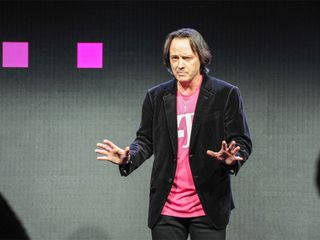T-Mobile reports largest quarterly growth in company history

T-Mobile has just announced its third quarter 2014 financial report, showing strong growth in several areas. The carrier reported its biggest growth quarter in company history with adding 2.3 million customers in the third quarter alone. In addition the company is reporting that it has already reached its year-end goal for LTE coverage, already having covered 250 million Americans, and it is targeting 300 million by the end of 2015. The company also said service revenues grew 10.6 percent year-over-year to $5.7 billion.
In terms of specific growth makeup, T-Mobile is reporting that it has had 1.4 million branded postpaid net adds, as well as 411,000 branded prepaid net adds.
T-Mobile has been quite aggressive with its 'un-carrier' initiative lately, and that vigor seems to be paying off for the company as it continues to add record numbers of customers.
Speaking on the company's rapid growth in LTE coverage, Neville Ray, Chief Technology Officer of T-Mobile, had this to say:
"Ahead of schedule" has become a recurring theme here. As of today, 250 million Americans can experience America's fastest nationwide 4G LTE network. No other network team in the nation can light up new network advancements so fast. We saw it with the initial roll out of our LTE network – we hit nationwide coverage months ahead of schedule. We saw it with the nationwide availability of Voice over LTE (VoLTE) just three months after initially launching in Seattle.
As for the rest of 2014, the carrier says it expects to finish the year strong, and it's hard to argue against those expectations.
The full press release can be found below.
Get the Windows Central Newsletter
All the latest news, reviews, and guides for Windows and Xbox diehards.
T-Mobile US Reports Third Quarter 2014 Results Best Quarter Ever of Branded Postpaid Net Adds and Double-Digit Percentage Service Revenue Growth
Third Quarter 2014 Highlights:
- Biggest growth quarter in T-Mobile's history:
- Best quarter ever of branded postpaid net adds – 1.4 million
- Branded postpaid phone net adds more than doubled quarter-over-quarter to 1.2 million
- Branded prepaid net adds up more than four times quarter-over-quarter to 411,000
- 10 million total customers added over the last 6 quarters – 2.3 million in the third quarter alone
- Service revenues grew 10.6% year-over-year to $5.7 billion
- Best ever Average Billings Per User (ABPU) of $61.59, up 4.2% year-over-year
- Adjusted EBITDA of $1.35 billion, flat year-over-year, impacted by record customer growth
With the fastest nationwide 4G LTE network:
- Already reached year-end goal of covering 250 million Americans – targeting 300 million in 2015
- Aggressively rolling out Wideband LTE and 4G LTE on 700 MHz A-Block and 1900 MHz PCS spectrum
- Continue to lead the industry in innovation:
- Un-carrier 7.0 – Wi-Fi Un-leashed: first US carrier to adopt Wi-Fi calling across all its new smartphones
- iPhone 6: T-Mobile's biggest device launch ever
Expect strong finish in 2014:
- Guidance range for branded postpaid net adds increased significantly to 4.3 to 4.7 million
- Guidance range for Adjusted EBITDA unchanged at $5.6 to $5.8 billion
BELLEVUE, Wash. – October 27, 2014 – T-Mobile US, Inc. (NYSE: TMUS) today reported third quarter 2014 earnings which demonstrated continued customer momentum and strong financial results.
T-Mobile reported 2.3 million total net customer additions with 1.8 million total branded net customer additions for the quarter, including branded postpaid net additions of 1.4 million and branded prepaid net additions of 411,000. The strong branded postpaid net addition performance resulted from continued momentum in phone gross additions, which were up 46% year-over-year.
"Despite our competitors' best efforts, the Un-carrier revolution made huge advances in the third quarter with record net new customers," said John Legere, President and CEO of T-Mobile. "More proof of the resurgent strength of our brand and the massive momentum behind the Un-carrier consumer movement."
Un-Carrier Delivering Results
Since launching Un-carrier in 2013, T-Mobile has transformed the wireless industry with innovations such as No Annual Service Contracts, equipment installment plans, the JUMP! device upgrade program, free international data roaming, and lifetime free data allowances for tablets. Earlier this year, the Company launched "Contract Freedom" which reimburses Early Termination Fees (ETFs) for individuals and families who make the switch to T-Mobile and launched T-Mobile Test Drive and Music Freedom in June. In the third quarter of 2014, the Company again expanded the Un-carrier portfolio with:
- Un-carrier 7.0: "Wi-Fi Unleashed": In September 2014, T-Mobile made voice and texting available worldwide, anywhere a Wi-Fi connection is available. The program also offers postpaid customers a Personal CellSpot device free of charge to boost coverage in more areas, and also enables free in-flight texting in a partnership with Gogo. T-Mobile is the first U.S. carrier to adopt Wi-Fi calling across all of its new smartphones as well as the first to introduce nationwide Voice over LTE ("VoLTE"). Customers can experience these groundbreaking technologies, including seamless handover between Wi-Fi and VoLTE, on the Apple iPhone.
Operational and Financial Highlights for the Third Quarter of 2014
T-Mobile continues to deliver strong customer growth and ended the third quarter of 2014 with 52.9 million total customers, an increase of 2.3 million total customers from the end of the second quarter of 2014 and 10 million total customers over the last 6 quarters. With 1.8 million branded net customer additions in the quarter, the Company grew its branded customer base at a record pace. Branded postpaid net customer additions were 1.4 million, including 1.2 million phone net additions, more than double the growth in the second quarter of 2014, and 204,000 mobile broadband net additions.
T-Mobile's branded prepaid business is expected to again lead the industry with 411,000 prepaid net customer additions in the third quarter of 2014, up more than four times versus the second quarter of 2014.
As part of the ongoing movement towards simplifying the business, the Company continued to drive the penetration of Simple Choice plans within its customer base. The portion of branded postpaid customers on Simple Choice plans was 84% at the end of the third quarter of 2014, up from 80% at the end of the second quarter of 2014.
Consistent with industry trends, T-Mobile's customers continued to migrate to smartphones. Total smartphone sales, including sales to branded postpaid and prepaid customers, were 6.9 million units in the third quarter of 2014, or 93% of all phone units sold.
In addition to strong customer growth, T-Mobile delivered strong financial results. In the third quarter 2014, the Company again produced the fastest revenue growth in the industry in both service and total revenues. Service revenues for the third quarter of 2014 grew by 10.6% year-over-year, primarily due to rapid growth in the Company's customer base and increased adoption of insurance and upgrade programs, partially offset by lower branded postpaid phone ARPU due to increased adoption of Simple Choice plans. Service revenue growth for the third quarter of 2014 accelerated compared to the second quarter of 2014 when service revenues increased by 7.1% year-over-year on a pro forma combined basis. On a sequential basis, service revenues grew by 3.6%. T-Mobile grew total revenues in the third quarter of 2014 by 9.9% year-over-year due to growth in equipment revenues and an increasing contribution from service revenues. On a sequential basis, total revenues increased by 2.3%.
Branded postpaid Average Billings Per User (ABPU) was $61.59 in the third quarter of 2014, up 4.2% compared to the third quarter of 2013, a significant acceleration over the 1.8% year-over-year growth in the second quarter of 2014. ABPU in the third quarter was the highest in the Company's history. Branded postpaid phone Average Revenue Per User (ARPU) increased sequentially by 1.1% to $49.84. Branded prepaid ARPU increased by 5.3% year-over-year to $37.59.
Branded postpaid phone churn amounted to 1.6% in the third quarter of 2014, down 10 basis points year-over-year, but up 10 basis points quarter-over-quarter due to seasonal factors. Year-over-year, the decrease was primarily due to the continued success of the Un-carrier initiatives.
Adjusted EBITDA for the third quarter of 2014 was $1.346 billion, flat year-over-year but down 7.2% sequentially. Quarter-over-quarter, Adjusted EBITDA was impacted by the higher costs associated with the record growth in customers, including higher selling, general and administrative expenses and higher losses on equipment sales. The Adjusted EBITDA margin was 24% compared to 26% in both the third quarter of 2013 and second quarter of 2014.
Network Expansion and Capital Expenditures
The Company's network expansion is continuing at an accelerated pace. T-Mobile's 4G LTE network – America's Fastest – now covers 250 million people, already reaching its year-end goal. The Company is now targeting a population coverage of 300 million people by year-end 2015. T-Mobile is rapidly deploying Wideband LTE, while at the same time rolling out 4G LTE on its 700 MHz A-Block and 1900 MHz PCS spectrum.
Cash capital expenditures reflect T-Mobile's continued investment in network modernization, 4G LTE deployment, and commencing the rollout of 4G LTE on its 700 MHz A-Block and 1900 MHz PCS spectrum. In the third quarter of 2014, cash capital expenditures were $1.1 billion, up from $0.9 billion in the second quarter of 2014 and up from $1.0 billion in the third quarter of 2013.
MetroPCS Combination
T-Mobile continued to make rapid progress on the expansion and integration of MetroPCS. As of September 30, 2014, MetroPCS was in 55 markets with nearly 11,000 points of sale in total, which includes 4,000 in the 40 expansion markets, an increase of 900 points of sale in the third quarter alone.
The MetroPCS customer base continues to rapidly migrate off the legacy CDMA network. At the end of the third quarter of 2014, 78% of the total MetroPCS customer base was already on the T-Mobile network. Approximately 63% of the MetroPCS spectrum has been re-farmed and integrated into the T-Mobile network at the end of the third quarter of 2014.
In July 2014, T-Mobile shut down the CDMA portion of the MetroPCS networks in Boston, Hartford, and Las Vegas. The CDMA portion of the MetroPCS network in Philadelphia was shut down early in the fourth quarter. Costs for these CDMA network shutdowns planned for 2014 are expected to be between $250 million and $300 million for the year, of which $97 million was recognized in the third quarter of 2014. The network shutdowns will facilitate the realization of the network synergies associated with the business combination of T-Mobile and MetroPCS.
2014 Outlook Guidance
T-Mobile expects to drive further momentum while continuing to invest in profitable growth. With the success of its Simple Choice plans and the continued evolution of the Un-carrier strategy, branded postpaid net customer additions for 2014 are now expected to be between 4.3 and 4.7 million, up significantly from the prior guidance of 3.0 to 3.5 million.
For the full year of 2014, T-Mobile expects Adjusted EBITDA to be in the range of $5.6 to $5.8 billion, unchanged from the prior guidance. Given the expected customer growth momentum, the Company anticipates an Adjusted EBITDA at the very low end of the range.
Cash capital expenditures are expected to be in the range of $4.3 to $4.6 billion, unchanged from prior guidance.
With this growth and rate plan migrations, the penetration of Simple Choice plans in the branded postpaid base is projected to be between 85% and 90% by the end of 2014, again, unchanged from prior guidance.
Dan Thorp-Lancaster is the former Editor-in-Chief of Windows Central. He began working with Windows Central, Android Central, and iMore as a news writer in 2014 and is obsessed with tech of all sorts. You can follow Dan on Twitter @DthorpL and Instagram @heyitsdtl.

